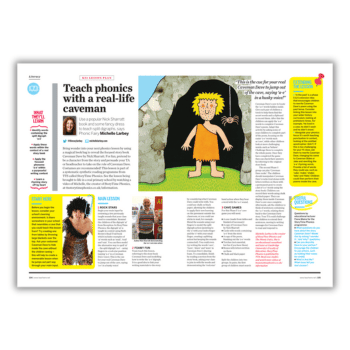Use a popular Nick Sharratt book and some fancy dress to teach a-e split digraph words…
Bring wonder into your next phonics lesson by using a magical book bag to reveal the focused storybook Caveman Dave by Nick Sharratt.
For fun, pretend to be a character from the story and persuade your TA or headteacher to take on the role of Caveman Dave. Costumes are recommended!
Learning objectives
- Identify words containing the split digraph ‘a-e’
- Apply these words within the context of a real storybook
- Apply the focused phoneme ‘a-e’ within a purposeful writing context
- Learn a rhyming story off by heart
a-e split digraph words
Before you begin the lesson, consider if there’s somewhere in your school that resembles a cave that you could teach this lesson from.
Try creating one from tables by throwing large blankets over the top. Ask your costumed Caveman Dave to hide inside the cave without the children seeing. This will help to create a memorable lesson when he jumps out part way through your main input.
Begin your main input by reviewing a few previously taught sounds that your class need to consolidate. Remind the children of the digraph ‘ai’ from Reception (‘snail’, ‘trail’, ‘rain’).
You can then model the alternative way to spell ‘ai’ – the split digraph ‘a-e’ – using fingers in a rock star position (saying ‘a-e’ in a Caveman Dave voice).
This is the cue for your real Caveman Dave to jump out of your makeshift cave, saying ‘a-e’ in a husky voice!
Michelle Larbey is the creator of StoryTime Phonics and The Phonic Fairy. She is an educational consultant and tutor at Cambridge University’s Faculty of Education. Download an a-e words handwriting and comprehension KS1 worksheet.











